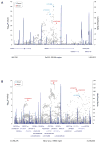Meta-analysis of five genome-wide association studies identifies multiple new loci associated with testicular germ cell tumor
- PMID: 28604732
- PMCID: PMC5490654
- DOI: 10.1038/ng.3879
Meta-analysis of five genome-wide association studies identifies multiple new loci associated with testicular germ cell tumor
Abstract
The international Testicular Cancer Consortium (TECAC) combined five published genome-wide association studies of testicular germ cell tumor (TGCT; 3,558 cases and 13,970 controls) to identify new susceptibility loci. We conducted a fixed-effects meta-analysis, including, to our knowledge, the first analysis of the X chromosome. Eight new loci mapping to 2q14.2, 3q26.2, 4q35.2, 7q36.3, 10q26.13, 15q21.3, 15q22.31, and Xq28 achieved genome-wide significance (P < 5 × 10-8). Most loci harbor biologically plausible candidate genes. We refined previously reported associations at 9p24.3 and 19p12 by identifying one and three additional independent SNPs, respectively. In aggregate, the 39 independent markers identified to date explain 37% of father-to-son familial risk, 8% of which can be attributed to the 12 new signals reported here. Our findings substantially increase the number of known TGCT susceptibility alleles, move the field closer to a comprehensive understanding of the underlying genetic architecture of TGCT, and provide further clues to the etiology of TGCT.
Conflict of interest statement
There are no conflicts of interest.
Figures


References
-
- Howlader N, et al. SEER Cancer Statistics Review, 1975–2012. National Cancer Institute; 2015.
-
- Znaor A, Lortet-Tieulent J, Jemal A, Bray F. International variations and trends in testicular cancer incidence and mortality. Eur Urol. 2014;65:1095–106. - PubMed
-
- Bromen K, et al. Testicular, other genital, and breast cancers in first-degree relatives of testicular cancer patients and controls. Cancer Epidemiol Biomarkers Prev. 2004;13:1316–24. - PubMed
Publication types
MeSH terms
Substances
Supplementary concepts
Grants and funding
LinkOut - more resources
Full Text Sources
Other Literature Sources
Medical
Molecular Biology Databases

